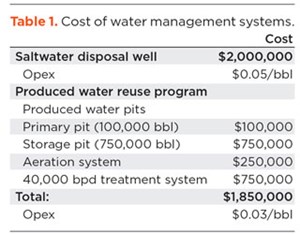Water management
After reading a few news articles over the last couple of weeks, I felt the need to discuss the issue of produced water management in the Permian basin. Some very unflattering things have been reported that I consider to be irresponsible. One of the terms used was “drowning in produced water.” So, let’s talk about some of the issues being discussed. First is the idea of insufficient injection capacity. Truth be told, there are stressed areas where there is insufficient disposal well capacity. It takes about 400 days from permitting to first injection, so well completions outpace disposal rather quickly. During this period of completions outpacing disposal, produced water is trucked further distances, which increases disposal costs.
On the surface this may seem like a significant problem as completion activity increases, but there is something called decline. Water-to-oil ratios in the Permian used to be around 8:1 about five years ago, but today are more like 4:1. Produced water volumes decline over time. As the ratio of older wells to new wells grows, the water to oil ratio declines. This has led to projections of produced water volumes in the Permian to be stabilized at somewhere between 450–500 MMbbl/month and not growing with increased oil production. There isn’t an explosion in the increased production of produced water.
Another concept addressed in these articles is this “new thing called reuse” that one article went on to refer to as unproven. Reuse has been going on for about 10 years—not a new concept. Most Permian operators have a produced water reuse standard, and most major operators have a reuse program. There are about 400 well completions/month in the Permian. Well completion fluid volumes have increased steadily.
A study in 2015 had this number as 270,000 bbl/completion. Today that is probably closer to 350,000 to 400,000 bbl/well completion. This becomes a tremendous outlet for excess produced water capacity. Well completion methods have trended toward slickwater fracs. Slickwater fracs are very tolerant to high-chloride produced water, making it a perfect alternative to fresh or brackish water. Most studies have shown that produced water use does not have a negative effect on well production and, in cases, there are some increases in well production.
One of the other concepts being discussed in recent articles is the pressuring up of some disposal zones, indicating there may be too much disposal and limiting the useful life of the zone. I don’t disagree that this is a concern, but a 2017 study shows that even though disposal by injection volumes are increasing, but pressures are decreasing overall, which is an indication that overall, disposal formations are not pressuring up, and there is still available capacity.
Induced seismicity is also being discussed as a threat in the Permian. Although there are some isolated areas where this is occurring, there has been no significant decrease in disposal capacity, due to induced seismicity in the Permian basin.
I don’t disagree that there are some threats to disposal capacity and some threats to produced water management in general, but this is not the crisis they describe. This is an opportunity. There is unused capacity, sitting out in the Permian basin, for produced water reuse, not just for completions, but also in enhanced oil recovery (EOR). The EOR practice of waterflooding is significant in the Permian basin, and waterflooding with produced water has been a practice used for many years.
And most operators in the Permian know that they can tap into this additional capacity and are developing produced water reuse programs. There is the occasional argument that produced water disposal is still cheaper than reuse. That may have been true a few years ago, not today. Reuse has become simpler, Table 1.
This sample comparison is a model, and it is likely that multiple disposal wells would be required to achieve 40,000 bpd, driving the cost above $2 million with no capacity guarantees. However, a reuse system can be built to guarantee capacity. Although this is not a detailed comparison, it’s apparent that reuse is a more efficient disposal system. Is this a reliable comparison? We installed five of these systems for an operator, with two more planned for this year. This same operator also opted to not build additional disposal wells, due to the savings in the reuse program.
So, am I saying reuse will replace disposal by injection? Of course not. Total water required for completions can range somewhere between 100 MMbbl and 180 MMbbl/month, while some reports show up to 200 MMbbl in the Permian basin. Produced water volumes in the Permian are somewhere around 450 MMbbl/month. Completion activity is volatile and trends with oil price. Other variables like oil takeaway capacity also can reduce completion activity, so completions can never be a reliable outlet for produced water reuse. There will always be a dependence on disposal wells.
My message is there is no crisis in the Permian basin. There may be a lag in the development of a disposal wells, but there is unused capacity in well completions and waterfloods. Reuse is underutilized and is the lower-cost option. There is opportunity in the development of more produced water reuse. ![]()

- Applying ultra-deep LWD resistivity technology successfully in a SAGD operation (May 2019)
- Adoption of wireless intelligent completions advances (May 2019)
- Majors double down as takeaway crunch eases (April 2019)
- What’s new in well logging and formation evaluation (April 2019)
- Qualification of a 20,000-psi subsea BOP: A collaborative approach (February 2019)
- ConocoPhillips’ Greg Leveille sees rapid trajectory of technical advancement continuing (February 2019)



